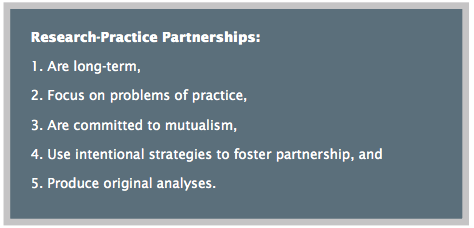My Google Scholar alert notified me that one of my articles was cited in an as yet not publisher preprint in Educational Researcher. I don’t usually bother with articles hidden behind paywalls, but I was intrigued by the title:
Coburn, C. E., & Penuel, W. R. (2016). Research–Practice Partnerships in Education: Outcomes, Dynamics, and Open Questions. Educational Researcher. http://edr.sagepub.com/content/early/2016/01/28/0013189X16631750.abstract.
However, I was NOT prepared to pay SAGE to rent the article for 24 hours for $36 US and I didn’t really want to wait until I could access it through my University library. Luckily Mr Google found an excellent white-paper article by the same authors that was sponsored by a Foundation and so available for free download :
Coburn, C. E., Penuel, W. R., & Geil, K. E. (2013). Research-Practice Partnerships. A Strategy for Leveraging Research for Educational Improvement in School Districts. William T. Grant Foundation, New York, NY. http://rpp.wtgrantfoundation.org/library/uploads/2016/01/R-P-Partnerships-White-Paper-Jan-2013-Coburn-Penuel-Geil.pdf.
The term “research-practice partnership” was new to me, though the idea has resonated with me for some time. The term comes from many types of professional practice in which researchers and practitioners & administrative agents in the practice, develop a formal partnership to undertake research together. Coburn et al. list 5 defining characteristics of these partnerships:

The article describes and gives example of successful partnerships and goes into some detail about challenges and concludes with recommendations for researchers, practitioners and funders. The paper highlights one of the most challenging (and vexing problems) of educational research. Most educational researchers work at Universities. In these contexts some educational researchers play a double role in both professional and pre-development of teachers for the K12 world and in developing and supporting innovation and improvement in teaching and learning at their home universities. I’ve mostly been involved in the later having undertaken a number of major projects (most notably the Athabasca Landing, with Jon Dron).
The systematic problem in higher education is that innovations that are developed within education faculties have a terrible time of moving to production and systematic use outside of the pilot contexts in which they were developed. The system sort of works in that the educational researchers publish in their own research journals and compete with other social scientists in the University and nationally for research funds to continue development. However, this type of research is much more strategic and mission critical to the University, than most of the other research taking place at the University. I don’t wish to denigrate research in other disciplines, but the University itself has (or should have) a vested interest in continuously improving its educational practice – across all disciplines. However, to both colleagues and administration this educational research is usually seen as merely one more form of social science research and thus very few “practitioner-researcher partnerships” with the characteristics above result.
In the science, medicine and engineering contexts, partnerships between commercial firms and university researchers regularly arise and in Canada we have government programs to seed fund these ‘scientific’ partnerships. In addition there are programs to encourage work placements, early trials and other incentives for partnership development. In the K12 world some school divisions have also partnered with educational researchers but those that I have been involved with have had challenges related to publication rights, participant permissions and as always, funding shortages.
Some Universities are broadening their “Teaching and Learning” units to include a mandate for innovation, which could serve as a home for these partnerships. However, in most contexts that I have observed, the Teaching and Learning units are focused more on professional development, mentoring and in some cases short-term funding for projects or conferences . They usually have little interest or funding to champion the type of long-term “design-based research” that I believe is critical to both understand and then to implement and continually evaluate new educational pedagogies and technologies.
Jon Dron and my own work in building the Athabasca landing is a prime example of opportunity lost. The Landing is an Elgg-based social network, that is designed to grow “beyond the LMS” to give a networked home for the distributed university. However, to date we have been unsuccessful at building a “research-practice partnership” with the university. From the University’s perspective, the Landing is just another research project, owned and championed by two individual faculty. The University has no real strategy or desire to implement this or other educational initiatives, in a production capacity. Without this type of testing and if successful, guarantee of support and adoption across both administrative and academic units, the Landing, as social networking platform, has not and will never reach “critical mass”.
Huge opportunity lost…..